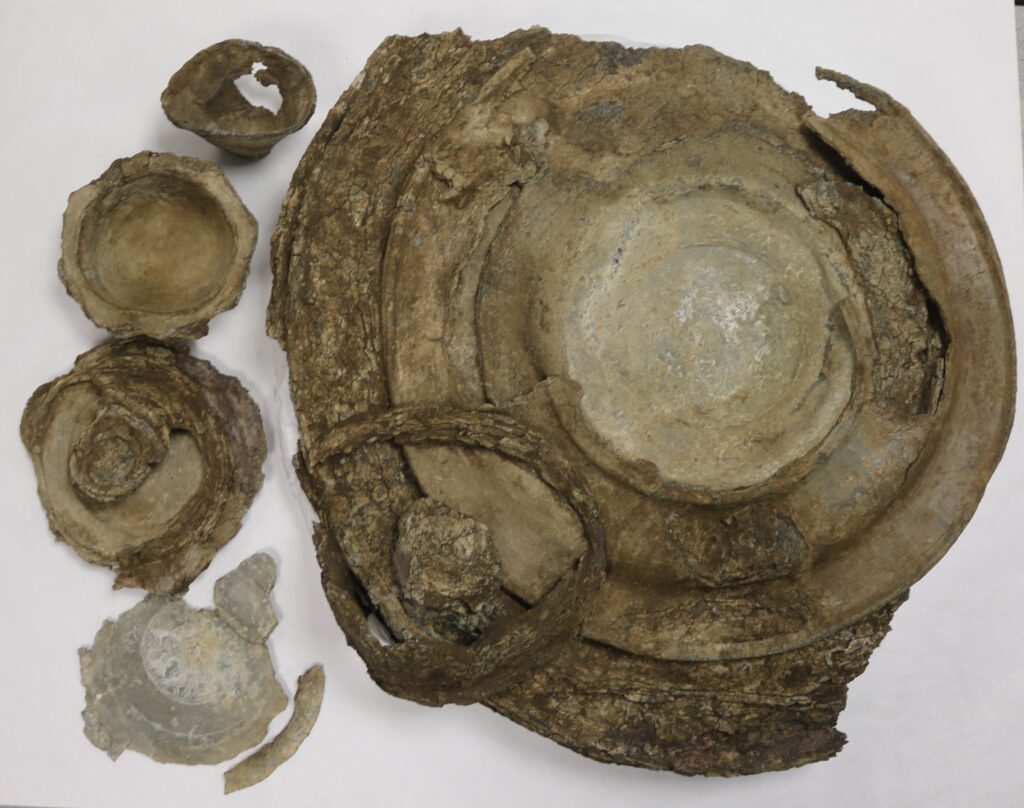
Metal detector user Martin White (pictured centre) discovered a 2000-year-old Roman hoard in Suffolk last Autumn – and it has just gone on display at the West Stow Anglo-Saxon Village and Museum. Here, he explains the whole process
Martin White has been a metal detector user for around a decade – and in the Autumn of last year he made his most important find to date: a 2,000-year-old Roman hoard. Martin made the rare discovery of late Roman pewter plates, platters, bowls and a cup in Euston, West Suffolk – the remains of the vessels were buried in a pit and carefully stacked, suggesting that they were placed as a single group, possibly for safe keeping or an offering. They have just gone on display at the West Stow Anglo-Saxon village and Museum, near Bury St Edmunds, until January 2024.

Martin, who had been taking part in an East of England Rally – an organised detecting event – says: ‘I’ve been detecting for about 10 years, and this is the most high profile find I’ve made so far, it was very exciting! We quickly consulted with the Archaeological Service so that the items could be removed and recorded, without being damaged. It was a privilege to be involved in the whole process, from discovery to excavation to seeing the finds go on display.’

Suffolk County Council Archaeological Service facilitated the excavation of the hoard, which was carried out by Wardell Armstrong and Norfolk Museum Service conservators.
It was then conserved by the Norfolk Museum Service conservators. All work was funded by the Euston Estate and East of England Rallies.

Faye Minter, Suffolk County Council’s Archaeological Archives and Projects Manager, says: ‘This is a significant discovery. The larger plates and platters were used to allow food to be served communally and the octagonal bowls may have a Christian reference. Similar hoards are found across southern Britain, including from the nearby large Roman settlements at Icklingham and Hockwold.’
Councillor Melanie Vigo di Gallidoro, Suffolk County Council’s Deputy Cabinet Member for Protected Landscapes and Archaeology, says: ‘It is amazing to think that this fragile hoard has survived thousands of years, and being discovered by Martin, that adds to the Suffolk story. This is a fantastic example of teamwork, with many organisations coming together to help preserve Suffolk’s history, all made possible by the generous support of the Euston Estate, East of England Rallies and, of course, Martin.’
The Duke of Grafton from The Euston Estate, says: ‘We were happy to donate this hoard and make it available for the public to see. Everyone can then share in the joy of this historic Suffolk find.’
And Cllr Ian Shipp, Cabinet Member for Leisure and Culture at West Suffolk Council which runs West Stow Anglo-Saxon Village adds: ‘We are very grateful for the kind donation of this hoard to West Stow Anglo-Saxon village and Museum and thrilled to be able to put it on display for local people to see. It adds a new strand to the story of our past in this area in the later Roman period – at a time just before the settlement at West Stow was beginning.’
Follow @SCCArchaeology on Twitter, Instagram and @SCCArchaeologicalService on Facebook.
Featured image: L-R: Andrew Blenkiron (Euston Estate Director), Martin White (finder) and Cheryl Dawes (East Anglian Rallies), viewing the conserved Euston hoard at West Stow Anglo-Saxon village and museum (credit: SCC)









Leave a Reply